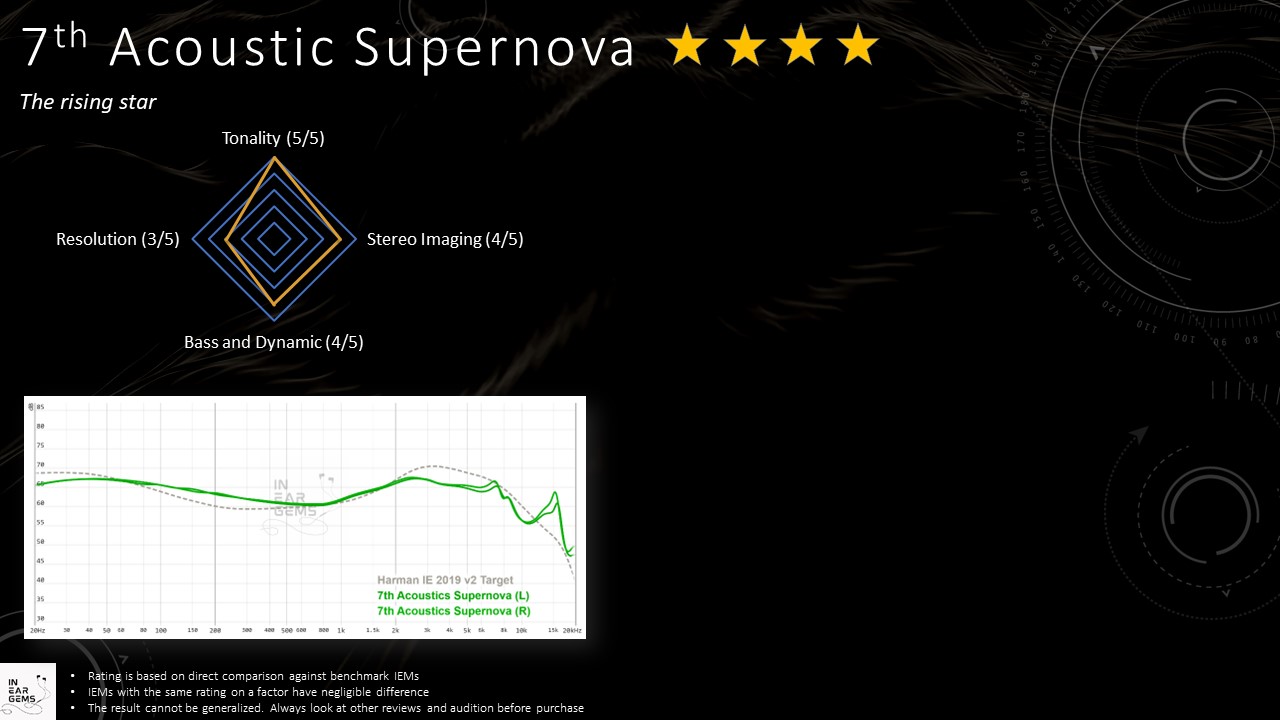7th Acoustic Supernova - The Rising Star
There is a fascination with small boutique shops in the audio hobby. After all, in a subjective hobby like ours, what could be more interesting than the idea of an audio geek working alone in a workshop to craft and share their vision of the ideal sound?
Today, we look at the flagship IEM from an Indonesian boutique that that has captured the heart and mind of many of my fellow reviewers, the Supernova from 7th Acoustic.
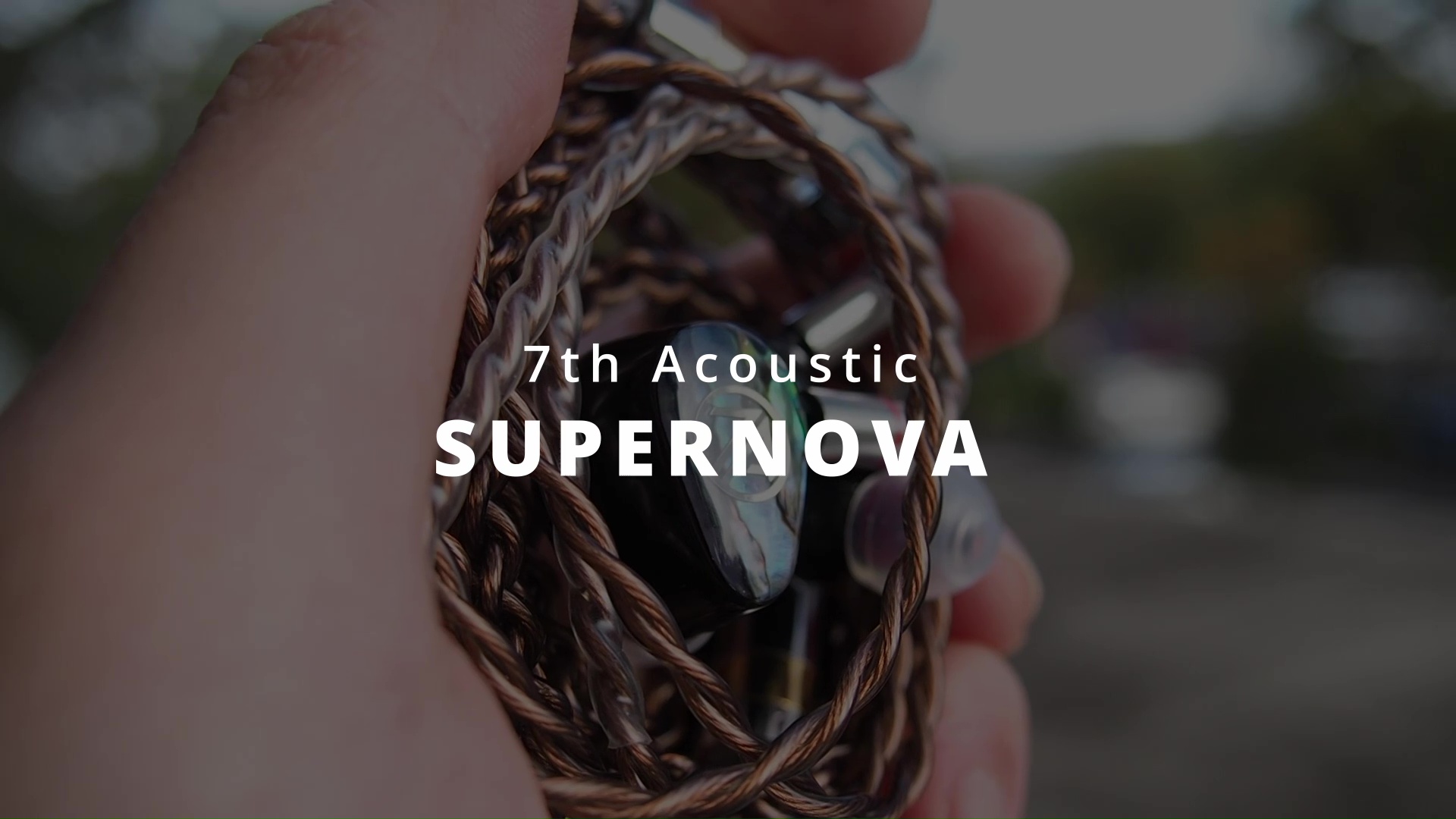
My review is also available on YouTube:
Forewords
- What I look for in an IEM is immersion. I want to feel the orchestra around me, track individual instruments, and hear all of their textures and details. I’m not picky about tonality, as long as it does not get in the way of immersion.
- I rate IEMs within with a consistent scale from 1 (poor) to 3 (Adequate) to 5 (outstanding). Ratings are assigned by A/B tests against benchmark IEMs, regardless of the retail price.
- Ranking list and measurement database are on my IEM review blog.
- Terms used in my reviews are consistent with the glossary by Headphonesty
- This review is possible thanks to the Australian review tour arranged by 7th Acoustic and Damz87 (Thank you!). I have no affiliation with or financial interest in 7th Acoustics. The unit retails for $800 at the time this review was published. You will need to reach out to 7th Acoustic on their Facebook page to order a unit.
Sources for listening tests:
- iBasso DX300 (for all A/B tests)
- FiiO K7
- Hidizs XO
Local FLAC files ripped from CDs or bought from Qobuz were used for most casual listening and A/B tests. My playlist for A/B tests can be found on Apple Music here.
All of my listening was done with Spinfit CP100 medium ear tips. I listen at a medium volume. I usually turn up the volume until the midrange is fully audible and detailed, unless a treble peak or overwhelming bass prevents me from doing so.
Specs
- Driver: 6BA (Dual Sonion vented bass BA, Sonion mid + uppermid BA, Knowles treble + upper treble BA.)
- Connector Type: 2-pin
- Impedance: 15ohm
- Sensitivity: unknown
Build and Comfort
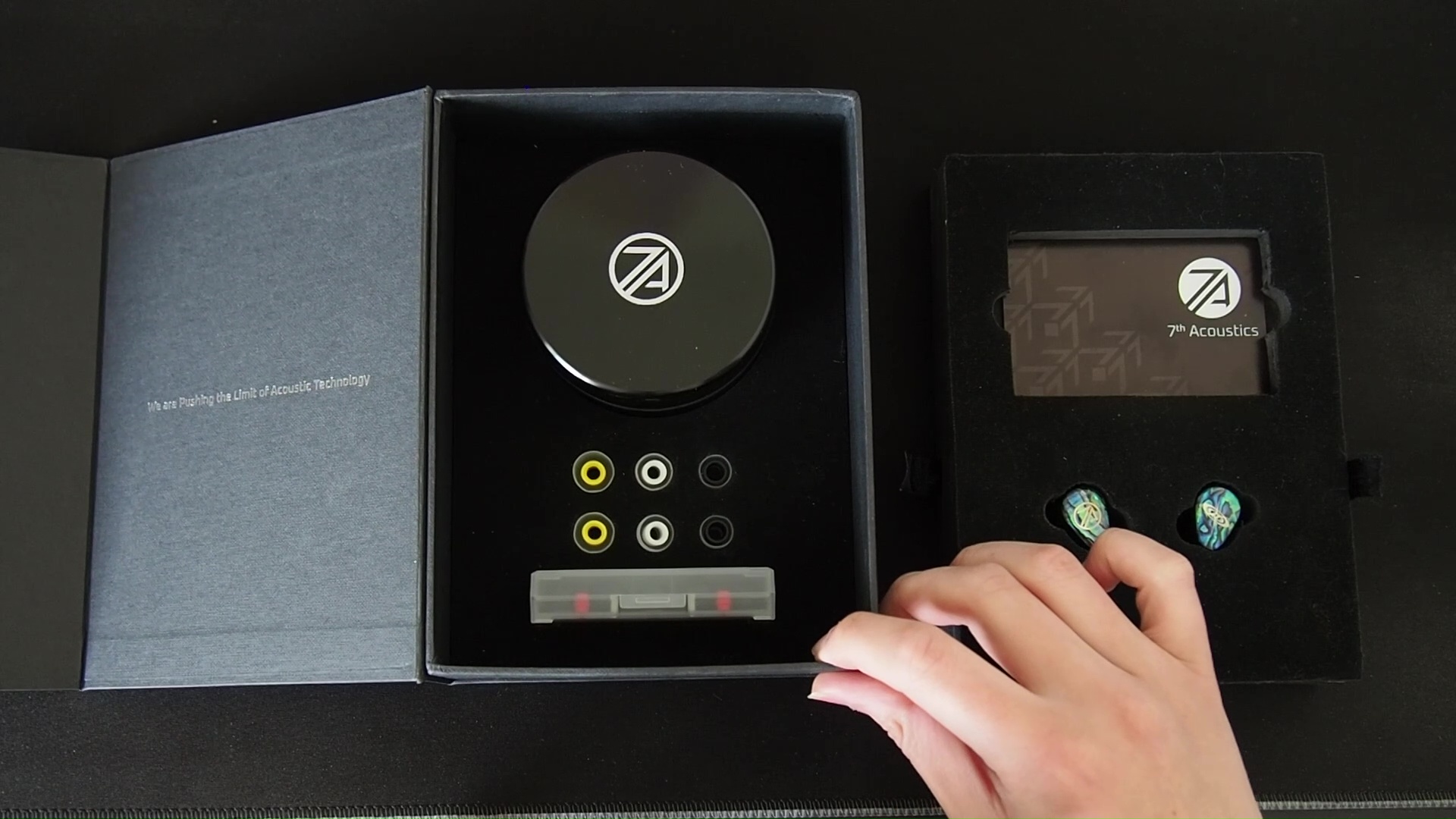
The packaging of Supernova is relatively basic. The design and presentation of the outer sleeve is quite simplistic. On the other hand, the inner box is nicely done with magnetic clasp and custom foam cut out. Everything is well protected.
Inside the box, you would find the IEMs themselves, an IEM cable, 2 sets of ear tips, and a metal carrying case.
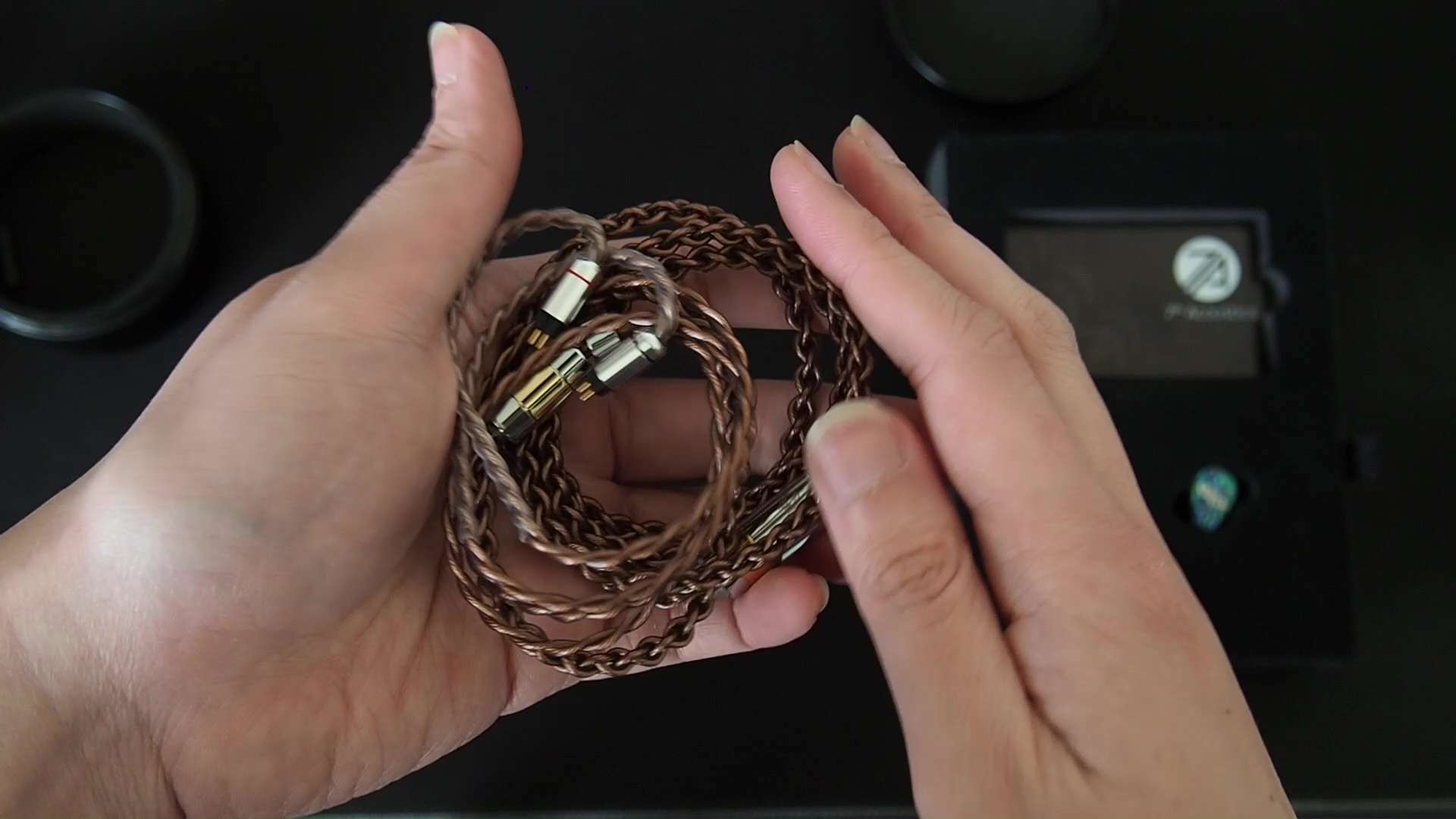 The cable has a 4-wire design with high quality metal hardware. However, the wires are fairly stiff and do not lay flat.
The cable has a 4-wire design with high quality metal hardware. However, the wires are fairly stiff and do not lay flat.
Supernova comes with a set of generic, wide bore silicone ear tips, and a full set of Final Audio Type E ear tips. I’m happy that 7th Acoustic includes the very useful carrying case of the Type E ear tips in the box, as you can use this case to pack a collection of favourite ear tips with you.
Supernova comes with a heavy duty metal carrying case. Inside the case, there is a layer of soft lining to protect the IEM. My only complaint about the case is that it requires a surprising number of rotations to open and close. The threading is also not very smooth.

Moving on to the ear pieces themselves. Supernova features a full-resin build, finished with beautiful abalone faceplates. The earpieces are quite thick. Luckily, the part of the earpieces making contact with the ears are smaller than other IEMs with similar driver topology.
The nozzles of supernova are also smaller than others. To put in context, you can use the eartips designed for 4 to 4.5mm nozzles with Supernova, while something like DiVa or Blessing 2 would require eartips for 5.5mm nozzles.
Smaller earpieces and medium nozzles make Supernova easy to wear. Despite having vents, the noise isolation of supernova is quite strong. Luckily, the IEM does not produce pressure build up or hot spot in my ears. I can wear this IEM comfortably in long listening sessions.
To achieve an optimal fit, meaning having the earpieces resting against the concha of your ears, I recommend using a shorter eartips to avoid lengthening the nozzles. I personally use a pair of Spinfit CP100 in medium size for all listening sessions.

Subjective Experience
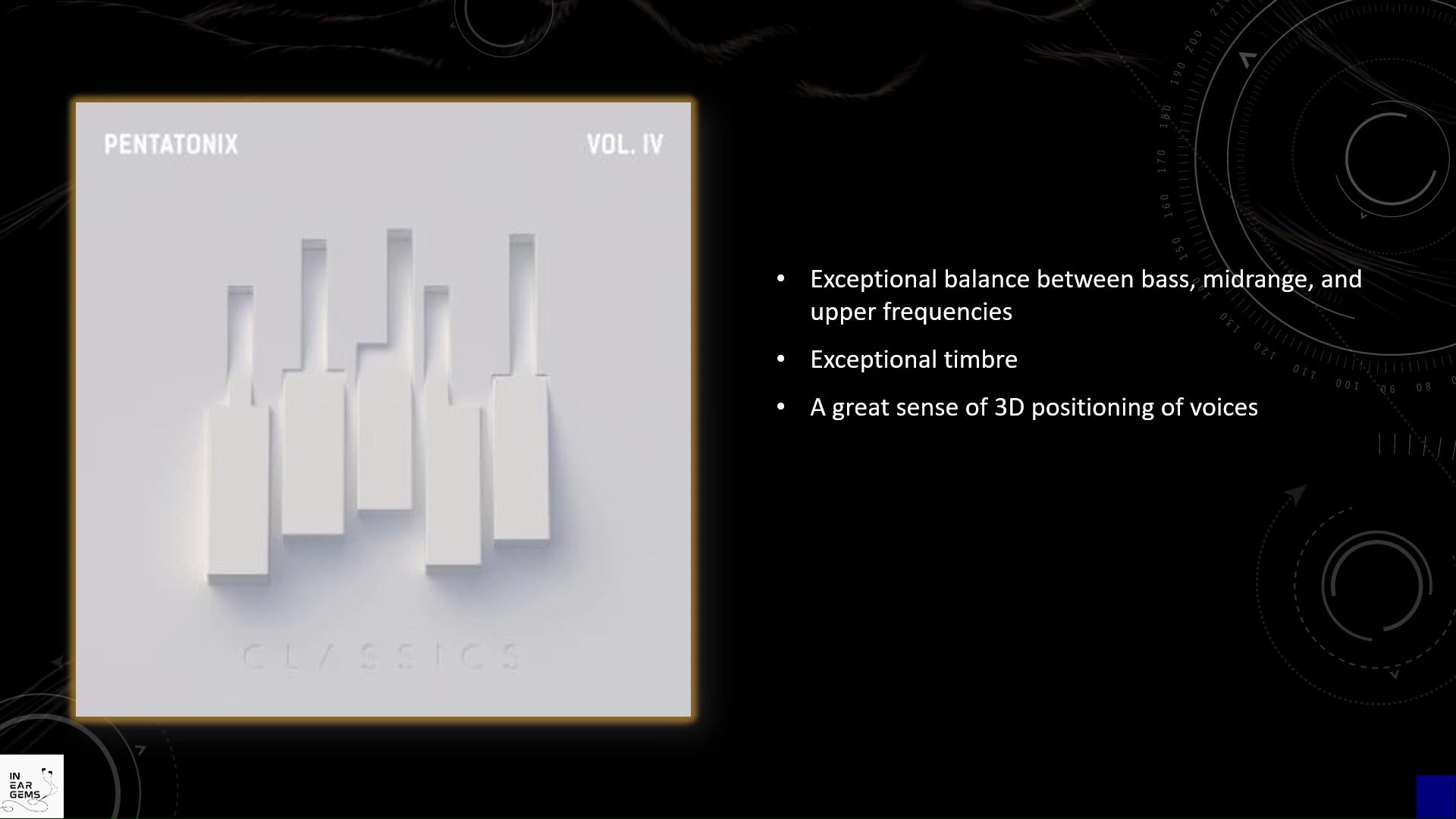
We start the subjective impression with vocal music from Pentatonix. When I listen to the Bohemian Rhapsody, from the first verse, I already know that I am listening to something special. To put in context, I did this listening test at a local coffee shop on a lazy weekend afternoon. When I click the “play” button on my music player, the coffee shop and all its ambience seem to fade away, as the soundstage opens up around my head and the voices of pentatonix members appear.
The tonality of Supernova demonstrates a high sense of realism while remaining incredibly balanced. The bassline by Avi is clearly presented with “oomph”. The kick drum beatboxing of Kevin sounds punchy. Every kick has a crisp attack and a physical sensation of the bass punch at the top of the note.
The soprano line of Kirstin pops out with great details and nuances, without becoming shouty or thin. The midrange lines by Mitch and Scott are loud and clear, without being overshadowed by the bass and the soprano.
At the same time, there is a strong sense of 3D positioning. It’s like every voice occupy a different position in the soundstage, from closer to further away, from lower to higher.

Moving on with Mendelssohn violin concerto
The violin has a perfect level of energy to sound crisp, clean, and stand out from the orchestra without a hint of thinness or harshness. The violin also has a great texture and details, creating a strong sense of realism.
Supernova also showcases excellent control over dynamic. It can convey a wide gradation of loudness and can present quiet passages without losing textures ad details. Therefore, it can maintain the sense of tension when James Ehnes moves from forte to piano passages, creating an almost magnetic sensation that draws me into the concerto.
The sense of space and depth is another strength that Supernova showcases in this recording.
However, the complexity of the orchestra in this recording also reveal a limitation of supernova in terms of the definition and separation instruments. Simply put, I need to spend more effort than usual if I want to follow individual instruments in the busy sections of the music.
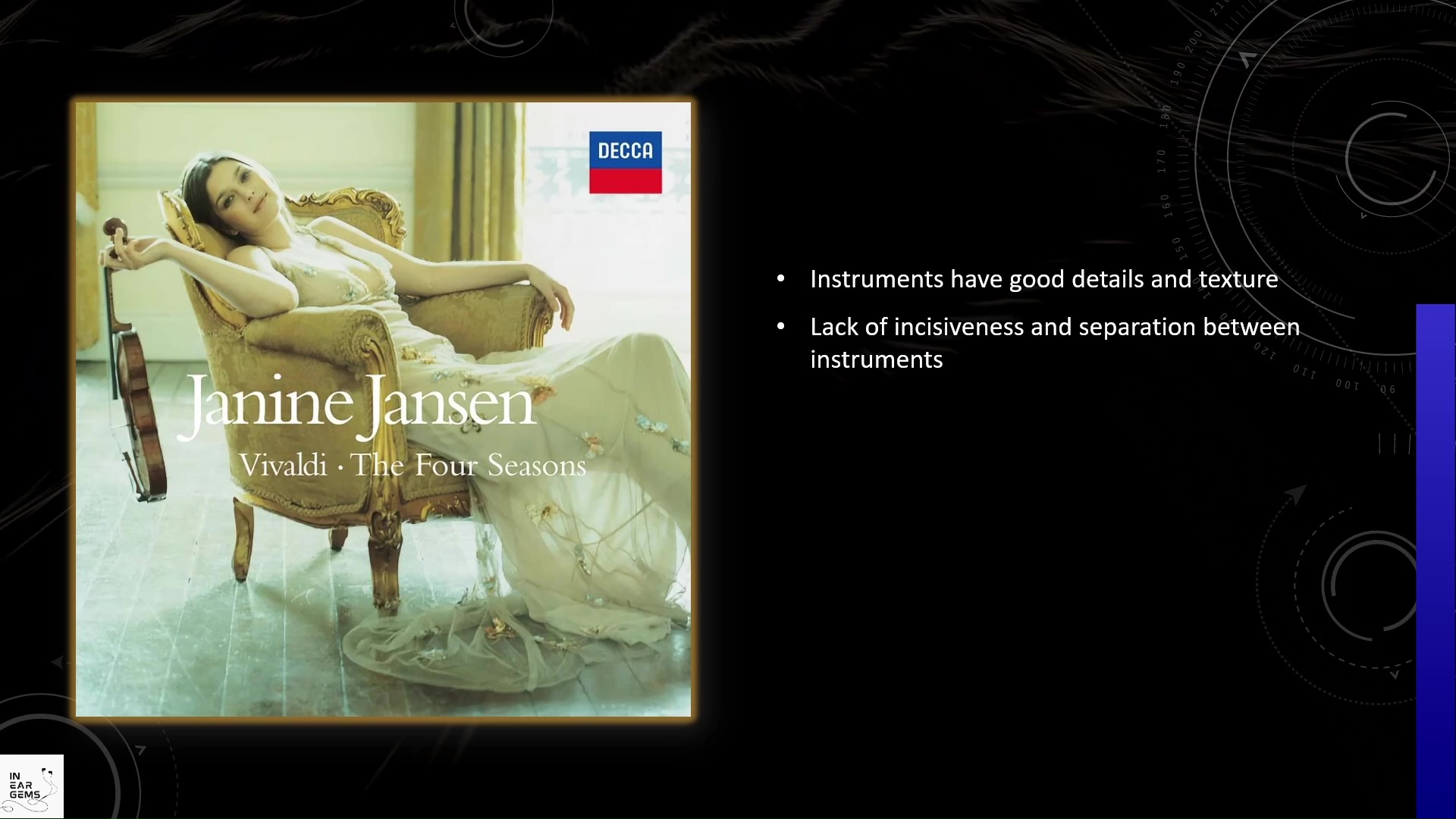
In order to test the resolution of supernova, I listen to the third movement of the Summer violin concerto by Vivaldi.
This piece highlights both the strength and the weakness of Supernova in terms of resolution.
On the plus side, I was quite pleased with the overall sense of detail and texture of all instruments. On the other hand, I was not impressed by the lack of incisiveness and separation between instruments.
To be clear, Supernova is not a poorly resolving IEM by any stretch of the imagination. However, in these dense recordings, its resolution does fall behind something like the Andromeda 2020, which is already aging by the current standard.
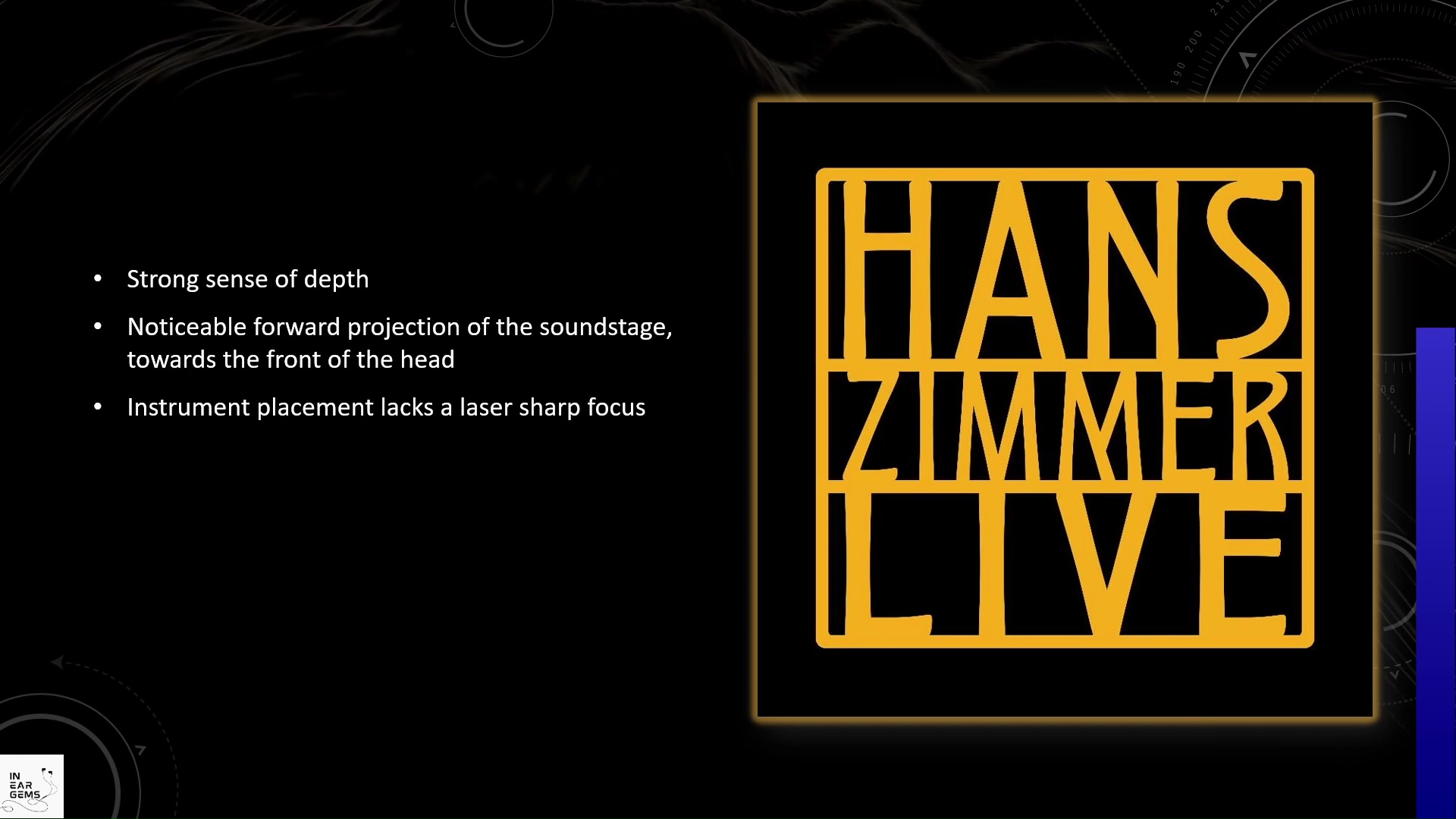
We conclude our subjective impressions with Live by Hans Zimmer.
I’m quite impressed by the bass response of Supernova. It’s punchy and powerful when the music calls for it, but it does not muffle the rest of the response when the bass punch is not needed.
Another advantage of Supernova is the soundstage. Across most tracks, Supernova demonstrates a strong sense of depth. The soundstage of Supernova has a noticeable projection forward, towards the front of the head. The center of the soundstage is also slightly pulled away from the head. Taken together, these characteristics helps Supernova sell the illusion of large soundstage coming from the front rather than a ball of sound inside the head.
The weakness of Supernova partially comes from the lack of incisiveness and separation. Simply put, the instrument placement of Supernova lacks a laser sharp focus. As a result, instruments do not form clear layers.
 Frequency Response
===
Frequency Response
===
Frequency response of Supernova against the Harman in-ear target. Measurements were done with an IEC-711-compliant coupler and might only be compared with other measurements from this same coupler. Visit my graph database for more comparisons.
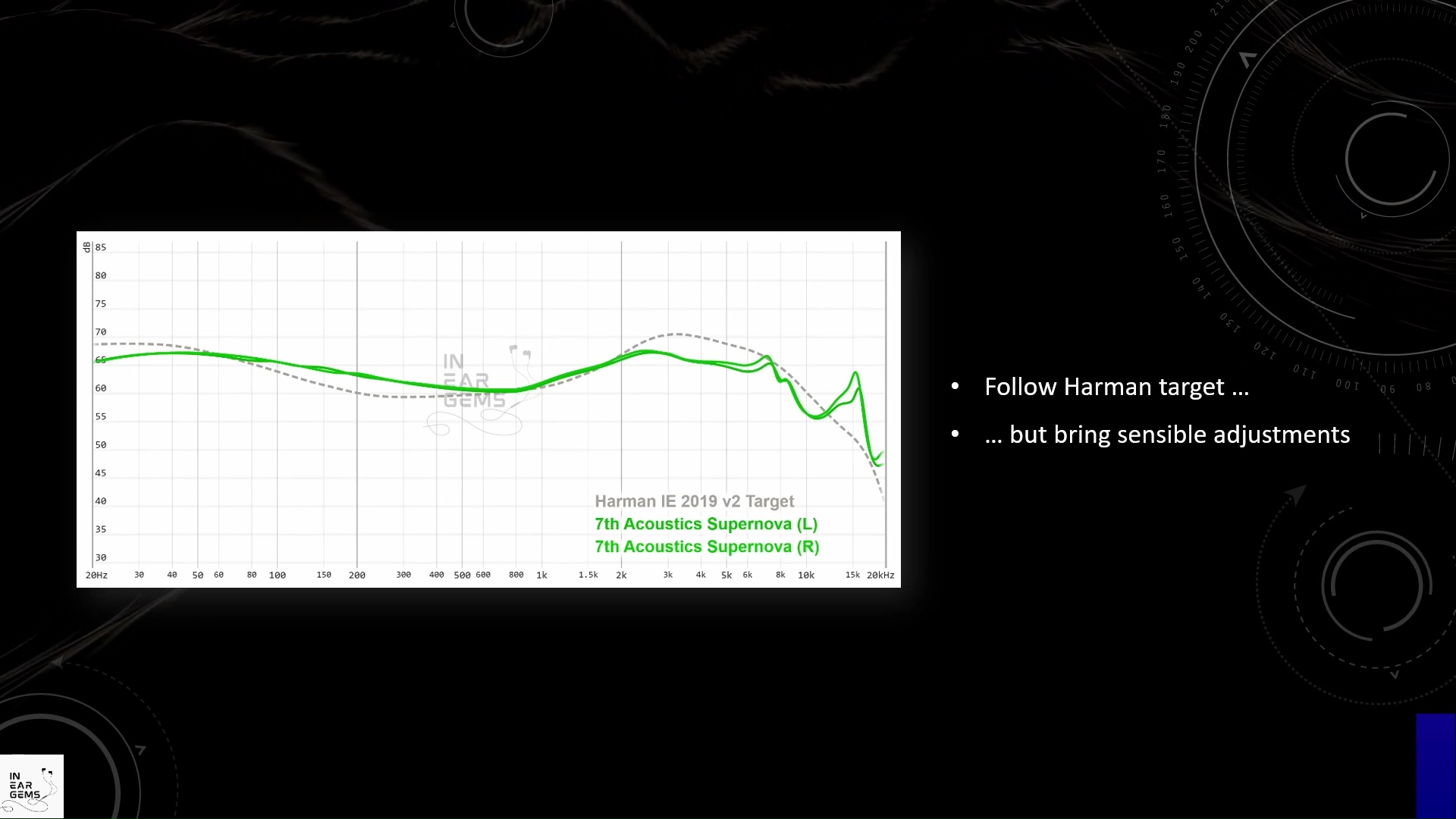
It is helpful to think of an IEM as a filter that highlights or subdues different parts of the incoming audio signal. This effect can be measured objectively by the squiggly lines above, called Frequency Response (FR) graphs, which measure how loud an IEM is at different frequencies from 20Hz (bass) to 20kHz (upper treble). Subjectivity is how your ears and brain interpret the effect of that filter on your music and decide whether it is “enjoyable.” There are some “rules of thumb” when it comes to tonality, but most interesting IEMs usually bend the rules masterfully.
How did supernova achieve its beautiful tonality? With the help of a 711 coupler we can see exactly how this IEM was tuned.
The best way to describe the tuning of supernova is that it follows the Harman target where it sounds right and modify the target wherever corrections are needed.
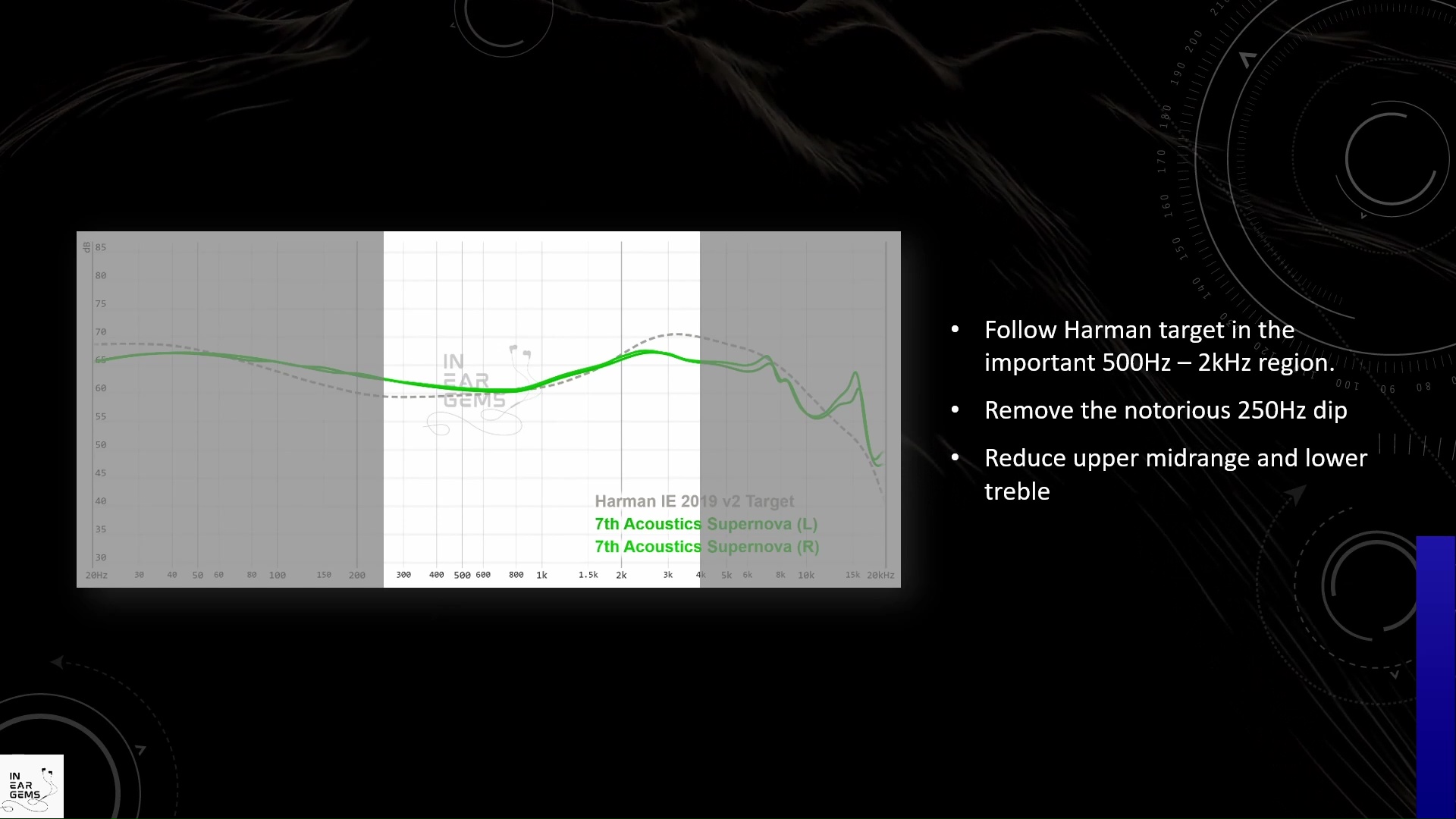
Supernova strictly follows Harman target in the important region between 500Hz and 2khz. This tuning ensures that supernova is free of boxiness, honkiness, and hollowness and other nasty problems in the midrange region.
However, Supernova deviates from the Harman target in two important ways. Firstly, it significantly reduces the upper midrange between 2kHz and 4kHz.
Secondly, it completely removes the notorious lower-midrange dip of the Harman target.
These changes together reduce the contrast between lower and upper midrange, ensuring that the midrange of Supernova does not sound thin and shouty like a true Harman IEM.
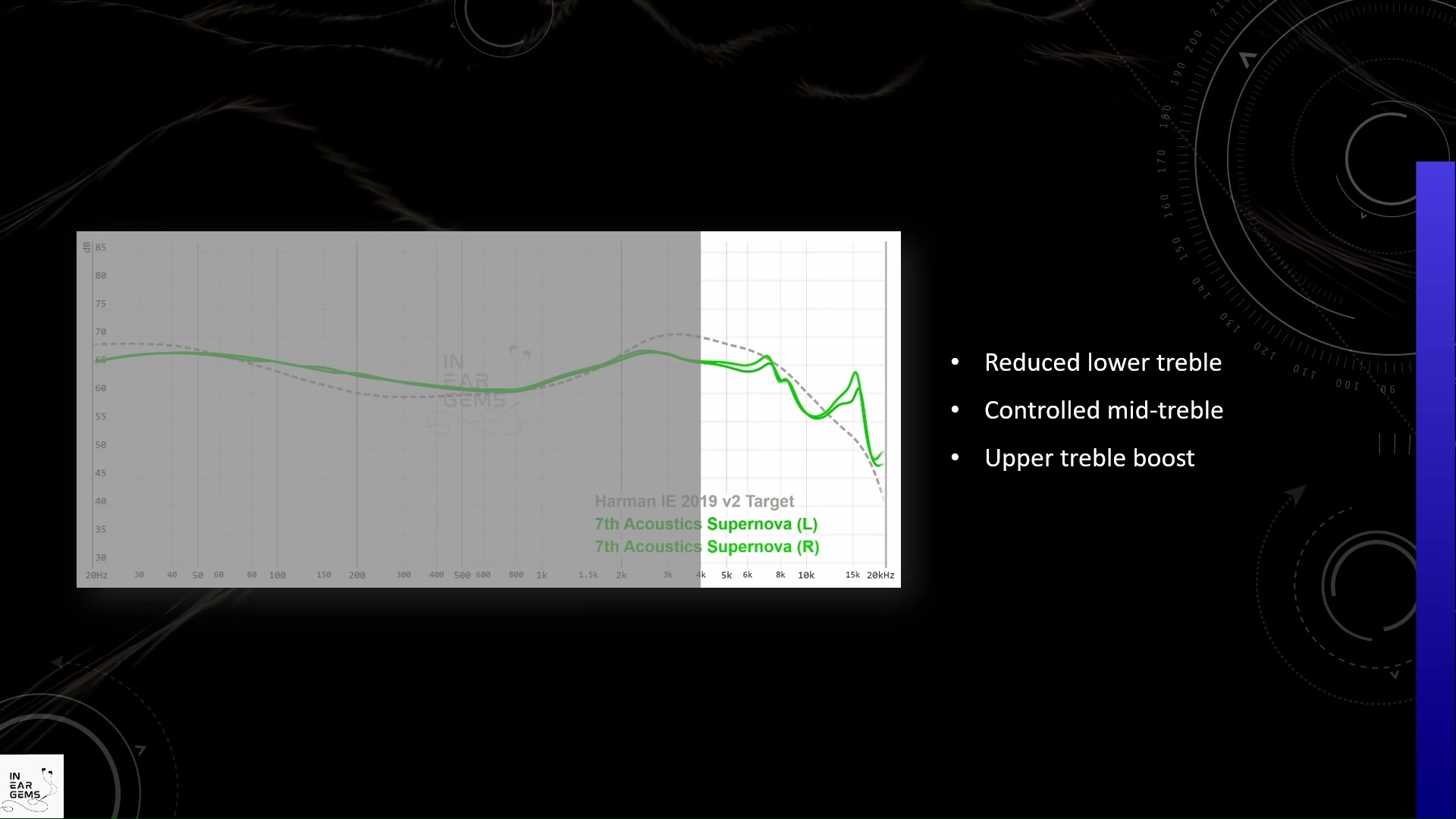
Moving on to the treble region.
Supernova significantly reduces the lower treble between 5 and 6kHz comparing to the Harman target. By doing so, it removes all the upper harshness and edginess.
Between 8kHz and 10kHz, Supernova again follows the Harman target. Personally, I find that the target provides a good idea for this region. Not too harsh, but also not too dull.
Finally, similarly to most modern IEMs, Supernova adds a peak in the upper treble, right around the upper range of human hearing. This tuning choice matches new research results from Knowle about listener’s preference in high frequencies.
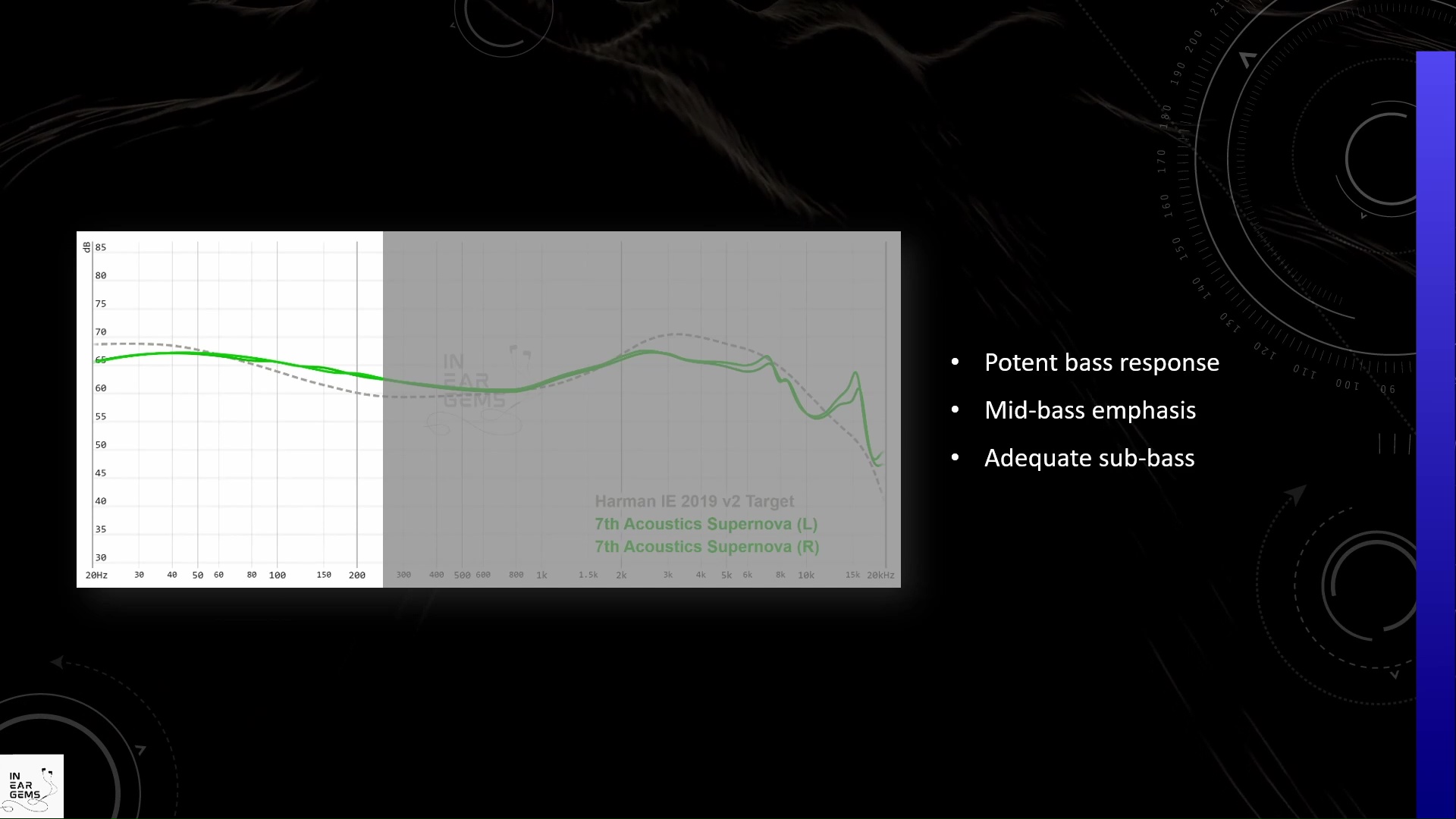
The subbass of supernova is slightly below the Harman target, which I find to be a good amount to create a physical sensation of the bass without overwhelming the rest of the response.
However, Supernova does not ignore the mid-bass region. As a result, you can also hear the bass rather than only feeling the subbass kick.
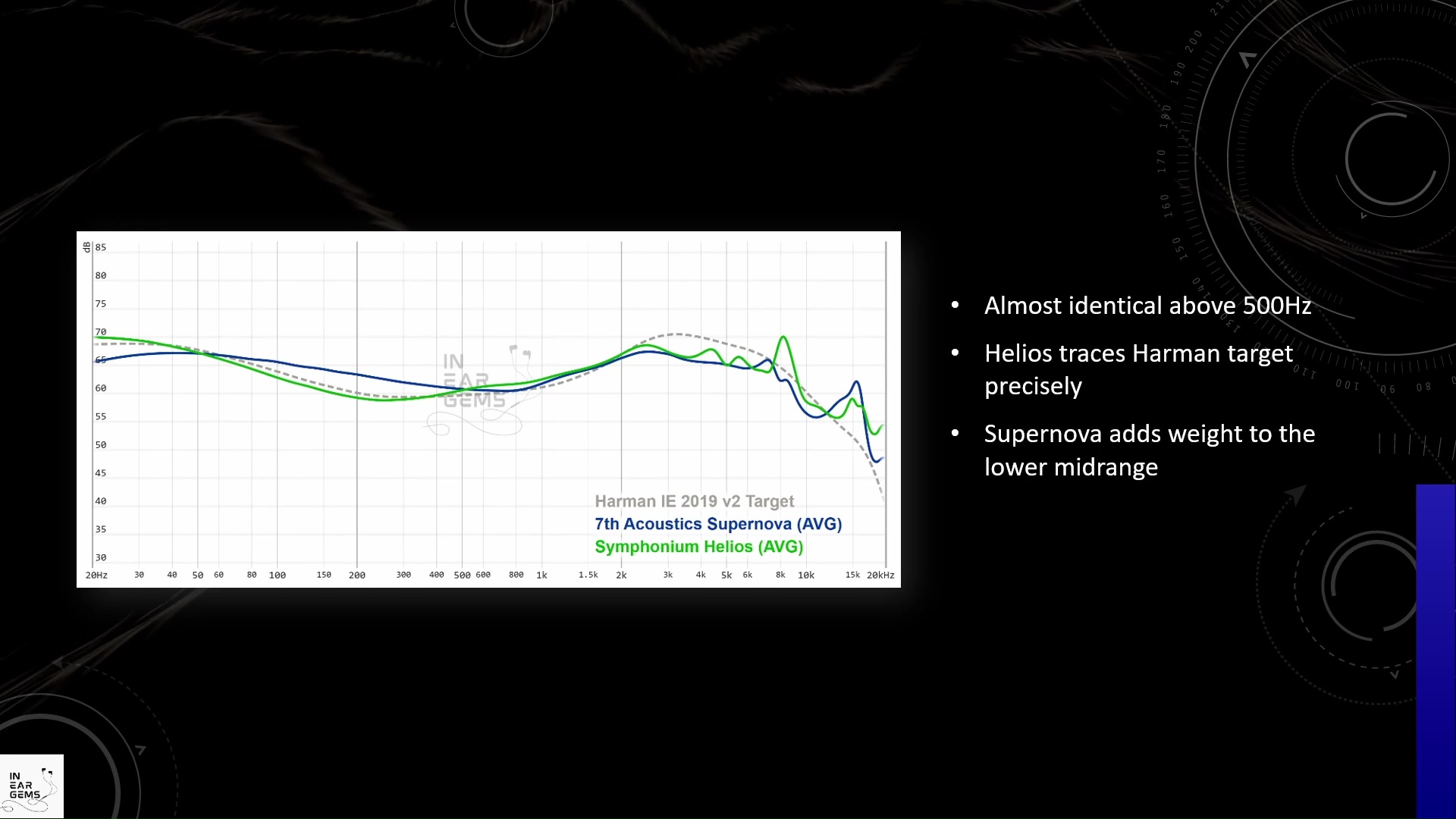
In order to appreciate the tuning of Supernova, let’s compare it with Symphonium helios, another IEM that features various adjustments over the Harman target. Looking at the graph, It’s rather striking how 7th Acoustics and Symphonium approach an identical vision of the tuning above 500Hz.
However, they differ significantly in the lower region. Helios follow Harman target to a T in order to convey the feeling of using a proper subwoofer, while ensuring that the midrange is clean and clear. Supernova, on the other, embraces the lower midrange and its potential problems such as muddiness and boominess.
So, which approach is more successful?
Debatable. Helios has a clean and open midrange without the usual harshness of a strictly Harman IEM. However, many, including myself, have pointed out that it does not have the most natural tonality, especially when it comes to male vocals and lower instruments like cellos. On the other hand, Supernova is natural and realistic across the spectrum, but it lacks the clean presentation of Helios. You need to pick your poison in this case.
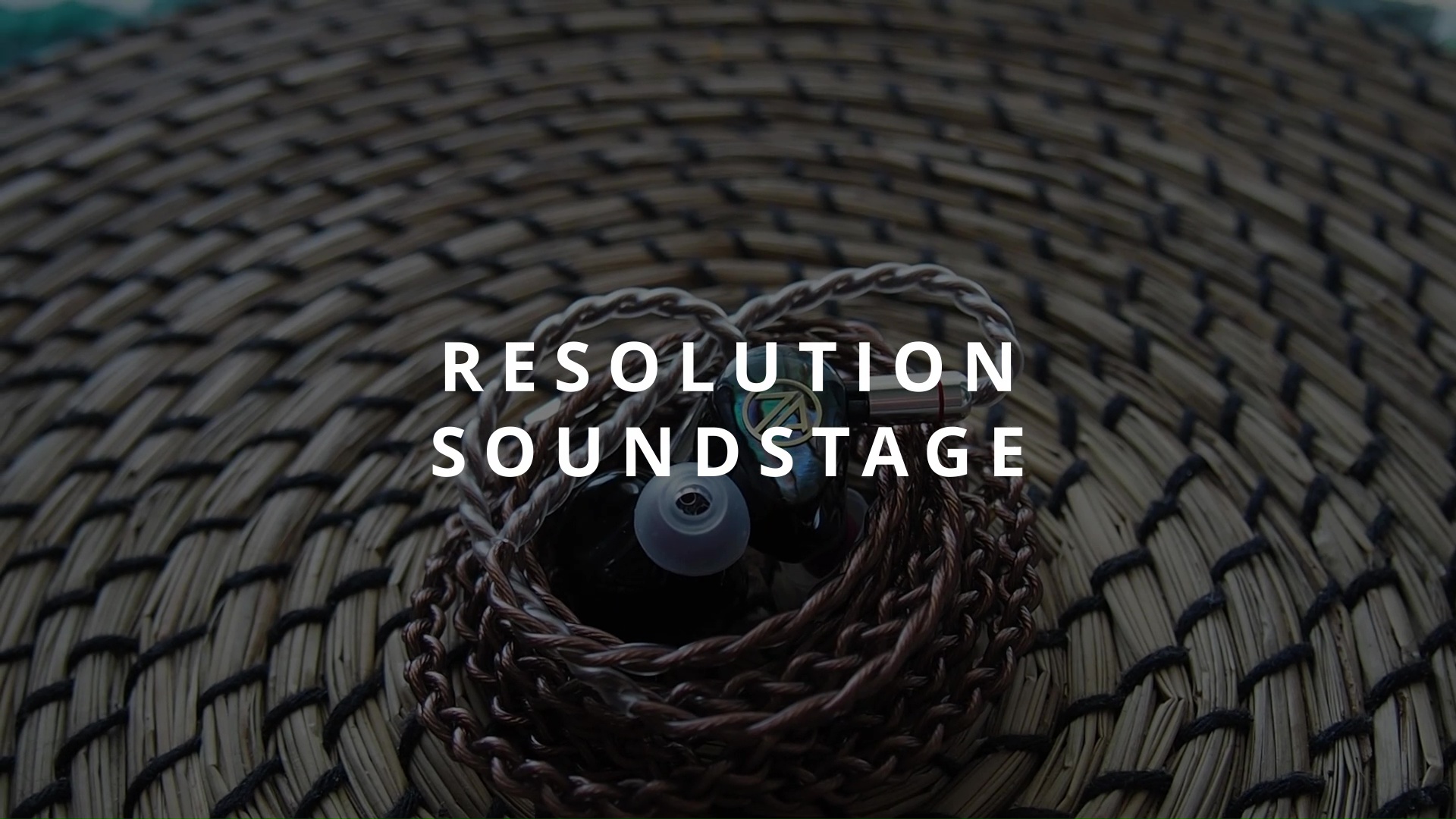
Resolution

Resolution is a fascinating subject due to the difficulty of pinning down what it really is. To me, “resolution” can be broken down into three components: (1) Sharpness, incisiveness, or “definition” of note attacks (see the figure above). (2) The separation of instruments and vocals, especially when they overlap on the soundstage. (3) The texture and details in the decay side of the notes. The first two give music clarity and make it easy to track individual elements of a mix. The last provides music details and nuances. Smooth and well extended treble response plays a crucial role.
Resolution is where Supernova stumbles. Simply put, this IEM does not offer a razor-sharp boundary between instruments. For example, when I listen to a complex orchestral recording, I need to spend more effort than usual if I want to follow individual instruments.
On the plus side, I was quite pleased with the overall sense of detail and texture of all instruments, even in these complex recordings. Supernova shines with simpler recordings such as violin solos. For example, when I listen to violin sonatas and partitas by Johannes Sebastian Bach, I can hear a decent amount of details and texture in the violin. The reverberation of the recording hall was also highlighted. However, in direct A/B tests, I still found that the aging Andromeda 2020 IEM is still crisper and more refined in both the midrange and the treble air.
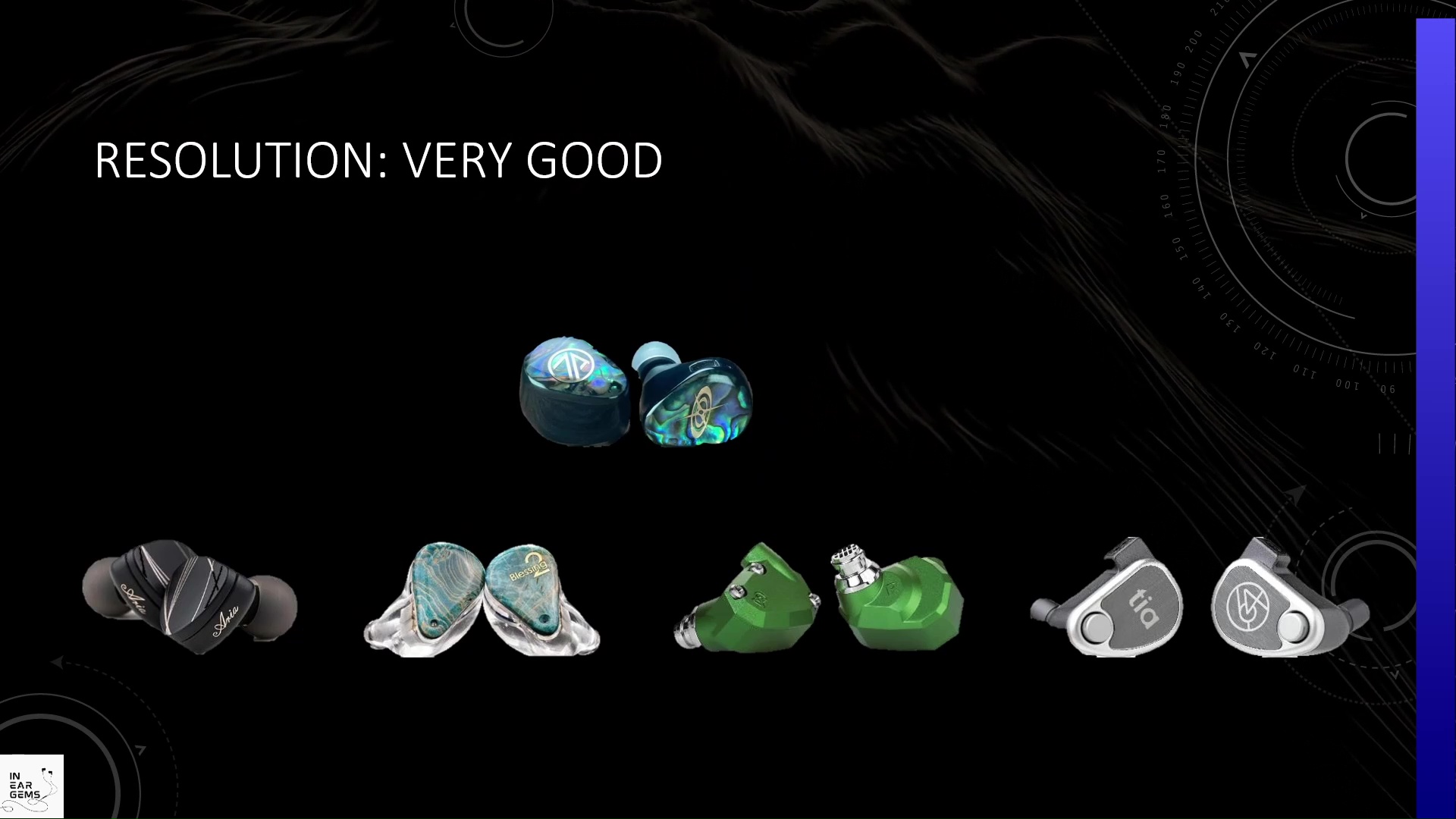
In conclusion, the resolution of Supernova is between the Blessing 2 and the Andromeda 2020, a level which I consider very good.
Soundstage Imaging

Stereo imaging or “soundstage” is a psychoacoustic illusion that different recording elements appear at various locations inside and around your head. Your brain creates based on the cues in the recording, which are enhanced or diminushed by your IEMs, your DAC, and your amplifier. Some IEMs present a wide but flat soundstage. Some present a “3D” soundstage with layering, depth, and height. In rare cases, with some specific songs, some IEMs can trick you into thinking that the sound comes from the environment (a.k.a., “holographic”)
If you read my reviews, you would know that if an IEM cannot convey a convincing and interesting illusion of space, I’m not interested.
Luckily, Supernova does not fail the soundstage test. This IEM manages to create a spacious and open presentation across my music library. The strength of supernova is a strong illusion of depth, meaning background instruments can sound as if they come from a distant, in front of the head. Moreover, with the right recording, Supernova can place the center of the soundstage slightly in front of the head, creating a convincing illusion that the stage is outside the head, rather than a ball of sound inside the head.
My only complaint about Supernova is the lack a laser focus instrument placement and separation. As a result, the layering between closer and further away instrument does not feel sharp and precise.
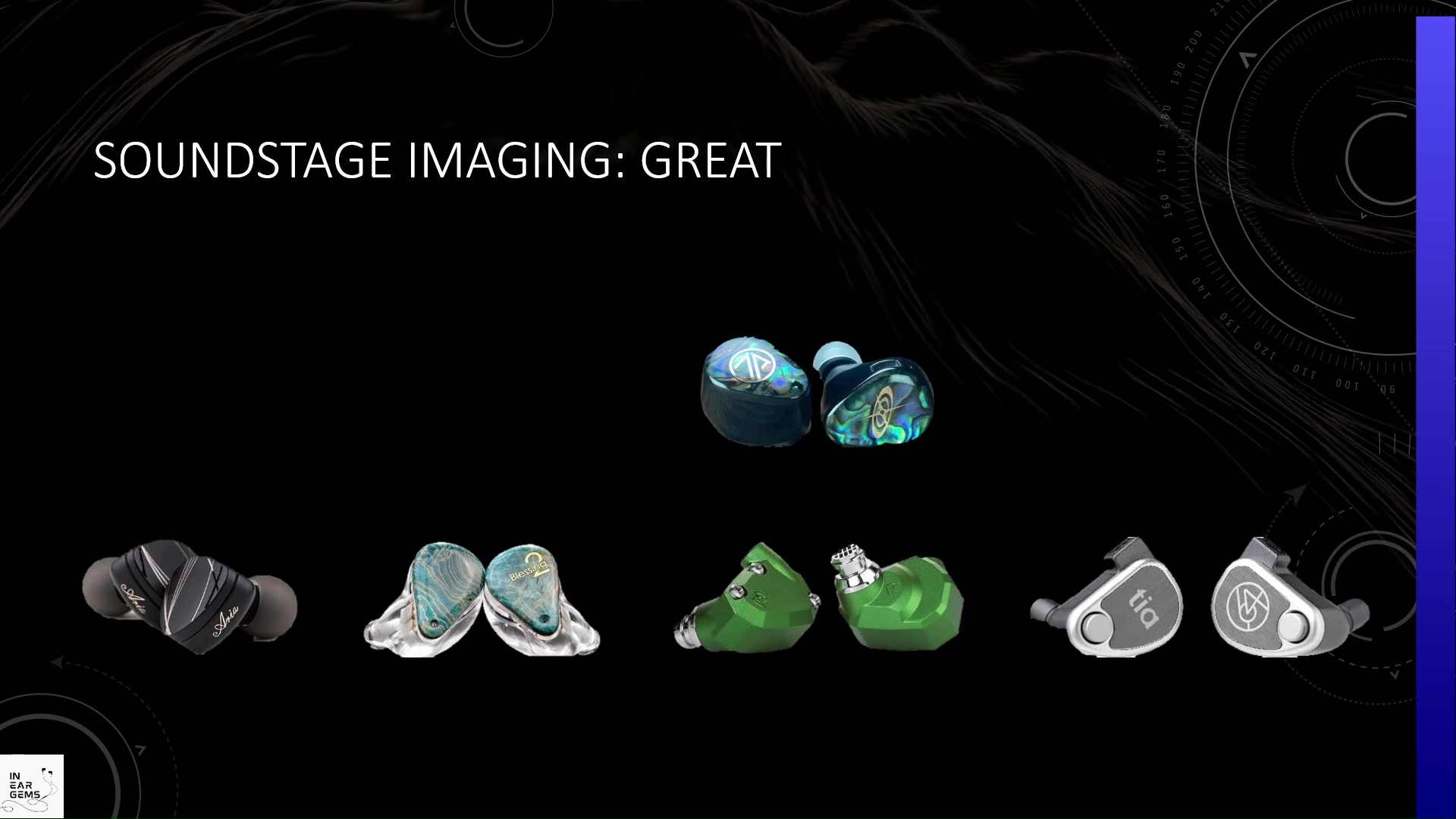
In direct comparison, it’s clear that Supernova has an edge against the Andromeda 2020 in terms of the spaciousness and the forward projection of the soundstage. However, the Andromeda has much more precise instrument placement within its smaller stage. It would be up to you to decide which one of these presentation is better. Personally, I find myself losing interest in the large but more cloudy presentation of Supernova quicker than the pin point presentation of the Andromeda. Still, in the grand scheme, I would place Supernova at the same level as the Andromeda 2020, which is great.
Conclusions
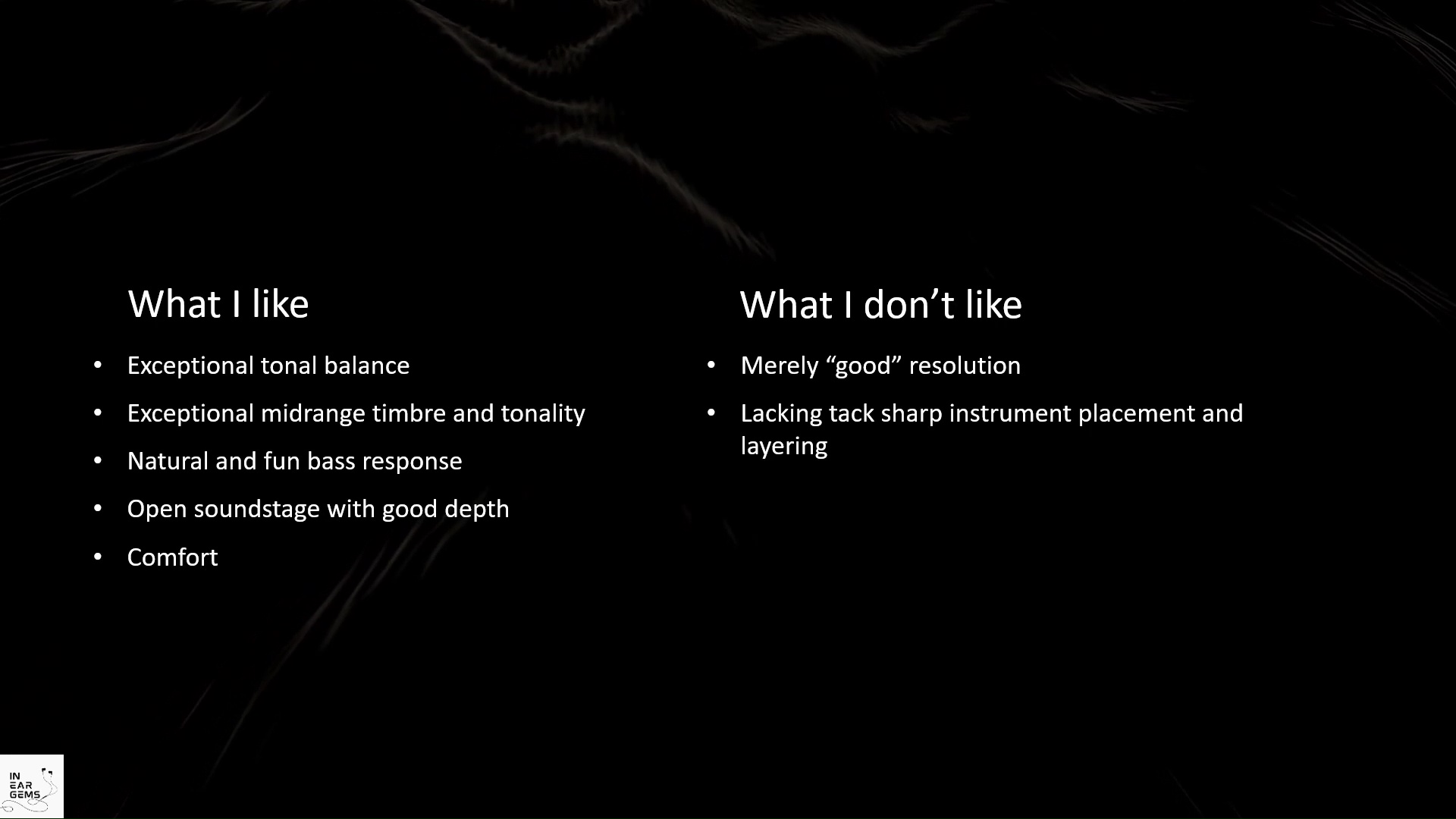
Despite my nitpicking about resolution and instrument placement, there is no denying that 7th Acoustic has done a lot of right things with Supernova. For someone who does not pay that much attention to tonality, I’m surprised by how impressed I am with the tonal balance and just the overall sense of realness of the tonality of Supernova. The bass response is also natural. It’s punchy when needed. It never sounds unnaturally dry and clean, yet it never overpowers the rest of the frequencies. The soundstage was also spacious and interesting. Luckily, Supernova can deliver all of those without compromising fit and comfort.
So, should you buy supernova?
Let’s look from the other direction and ask why you SHOULDN’T add this IEM to your collection. If you want the midrange to be thin and clean, Supernova isn’t for you. If you want you IEM to have razor sharp instrument placement and separation, you might also want to avoid supernova. If you want your IEM to have exaggerated bass response, look else where. Finally, if you want your IEM to present music with substantial colouring, such as very thick lower midrange or spiky, sparkly treble, you wouldn’t find that presentation in Supernova.
If you preference does not fall into those cases, supernova is worth a listening. It is one of the few IEMs that make me say “what a beautiful tonality.”
Absolute Sonic Quality Rating: 4
Bias Score: 4
